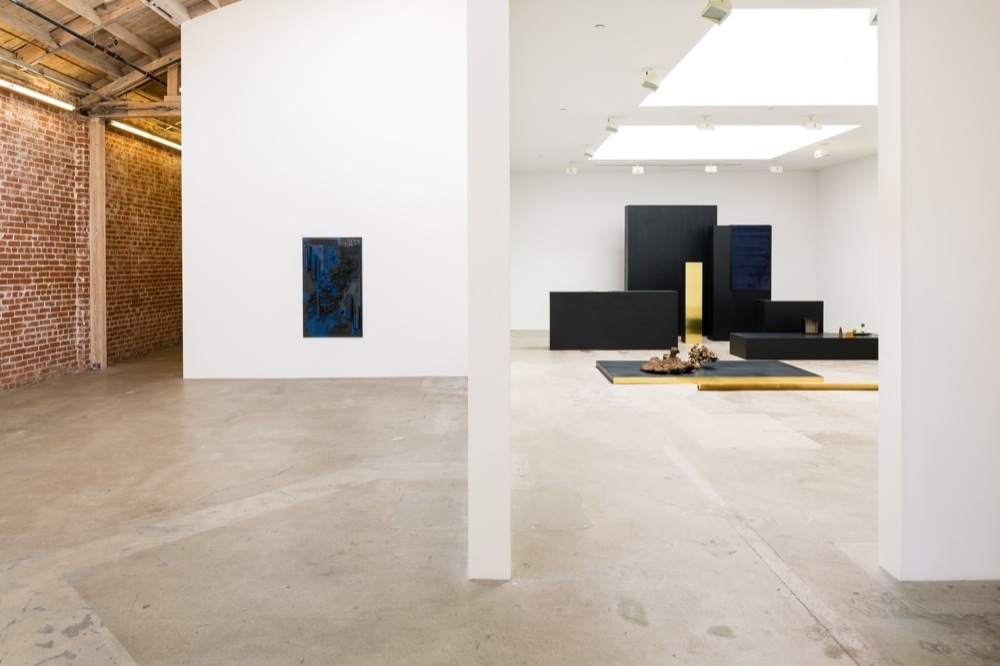Deconstructing Classicism
Trained as an art historian, artist, and curator, Isabelle Cornaro deconstructs classical landscapes through minimal and immersive forms. Each piece, made for a series of large-scale installations, consists of pedestals ranging in size, arranged to form a landscape when seen from afar. To create perspective, the rectangular structures become taller as the installation becomes deeper. Moving through the installation separates the plinths, however, refocusing the viewer’s gaze upon the decorative objects they support. Many of the objects evoke notions of a man-made society (jewelry) and the natural world (wood). They also lend themselves to Cornaro’s attention to perspective, as smaller objects are placed at the furthest point of the installation and atop the higher bases, while larger objects appear toward the front, closer to the ground. Currently at Hannah Hoffman Gallery in Los Angeles, the Paris-based artist presents her latest development within the series, simply titled Landscape, which incorporates rolls of velvet fabric and brass plates amongst mostly black, alluding to her exploration of fetishism.
“Since classical landscape paintings are built in the same way, there are rules to build an equilibrated image,” the artist says of her process. Cornaro doesn’t begin with specific source imagery, but rather takes the established rules and applies them to her minimal concepts. Alongside Landscape at Hannah Hoffman, Cornaro also presents works from her “Orgon Doors” series, which mimic the overall visual effect of the installation but on a 2-D plane. The wall-based rubber castings reference 16th- and 17th-century Mannerism, yet this is done through decidedly industrial compositions. Another pair of works, categorized as “drawings” by Cornaro despite their lack of graphite or any material traditionally used for drawing, present thin bands of human hair wrapped tightly around painted wood. The works’ simple, grid-like formations and geometry at once reflect their neighboring Landscape.
In addition to her show in Los Angeles, Cornaro currently also has a solo exhibition at La Verrière (an art space at the Hermès boutique in Brussels) and was just named the 2016 Curator at the Ricard Fondation. We spoke with her over the phone, just after she returned to Paris from L.A.
EMILY MCDERMOTT: What drew you toward gold for this installation?
ISABELLE CORNARO: One of the paintings I started to work from was a landscape that included water. I was interested in the notion of reflections, in regards to the notion of fetishism, which is quite important in all of these installations. I thought it would be interesting to have a mix of matte surfaces and very shiny, reflective surfaces. To me, the reflective surfaces give a sort of liquidity to the work and also comment on the notion of fetishism.
The velvet plays a bit on the same idea of fetishism because it has something very optic—you want to look at it, you want to touch the surface. It’s very tactile, but it’s also quite matte. It comes as a sort of opposition. With the very shiny reflection, it absorbs the light.
MCDERMOTT: Can you also tell me about the casts, especially the one with the blue abstract pattern? I don’t recall seeing anything that abstract in your castings before.
CORNARO: For the first time in this series, indeed, I introduced a color that’s strong as a splash. It was a way of adding an expressionist gesture, but very fixed, very frozen, inside something that is composed. I play with a lot of different moments in artists’ stories and objects from common popular culture. I like the idea of mixing different references—or images or patterns or archetypes—I have in mind in order to recreate a new comment on it.
MCDERMOTT: Regarding the hair drawings, why do you refer to them as drawings? Traditionally speaking, they aren’t exactly drawings…
CORNARO: I often go beyond the traditional terms we give to artworks. For instance, a large installation, it’s a sort of drawing in the space. But in the opposite way, the drawings with the hair did use Plexiglas and drawings, but they are composed like lines and have something very graphic. It all starts from really abstract lines that I put together and it’s really abstract minimal work, so that’s why I call it drawing. Actually, these drawings were sort of prototypes for the installation because they are built in the same way. You have an abstract minimal grid, a geometric grid, and inside this grid, there are figurative or emotionally charged elements. For the drawings, it’s the hair, and in the installation it’s the objects.
MCDERMOTT: Why hair?
CORNARO: Because all these works are about the relation we have to objects as extensions of ourselves, with feelings, memories, emotions or so on. So the hair is one of our first extensions of ourselves, because it’s both organic and very like an object when it’s cut or out of the body.
MCDERMOTT: Where did you get the hair?
CORNARO: It started incidentally because someone gave me hair that was quite old and I used it for drawings. After, I collected it from shops for people who want extensions—you know, you can buy human hair in these shops for extensions. It’s a very popular part of pop culture. You want to get your extensions and you go to these shops.
MCDERMOTT: It circles back to the idea of fetishism.
CORNARO: Exactly, and also the representation of the self and how you show yourself.
MCDERMOTT: How do you see yourself in these works? Do you even see yourself in these works or is it more a reflection of society?
CORNARO: In the first place, especially for the large installation, it was very much to relate to society, specifically thinking of the colonial history of European countries. There were a lot of references to colonialism, for instance to the colonialism of Africa by the French, Belgian, British, and so on, and to the notion of imperialism. After that it moved to something more personal and kind of existential—this idea that yes, the consciousness of your own death or the will to grab things with the gaze. All these optic and sub optic feelings are very personal, emotional, and existential things, more than social.
MCDERMOTT: What drew you to the African colonies as a starting point?
CORNARO: I actually was raised in post-colonial Central Africa. I was also, with art historians, tracing the notions of landscape and how you build a landscape and how this is a kind of ideological setup, the representation of the landscape. At some point it mixed with things regarding the colonial historical frame that I was also interested in.
MCDERMOTT: Switching topics, I know that you were also just named the 2016 curator for the Ricard Foundation. What are your plans for that?
CORNARO: I actually don’t know yet. I’m just starting now. At the beginning I thought that it would be a rather long list of 12 people and now I’m looking at the precedent edition and it seems like it’s good when it’s a bit smaller. In the preceding editions it was six to eight people, so I know the amount of people but I don’t know who yet…
MCDERMOTT: And you also have a show in Brussels at the Hermès Foundation that has a lot of bright colors and involves the use of spray paint. Can you tell me a little bit about that show and what some of the starting points were for it?
CORNARO: The installation is also part of the landscape series, such as the one that’s at Hannah Hoffman, but I wanted to reduce the amount of objects in the installation. In this installation there’s a perspective created with both the sizes and arrangements of the pieces, but also with the objects. You have a big object in front and a small object in the back. At the Foundation Hermès there are less objects; I thought it would be interesting to build atmospheric perspective, so to say, with the colors. I was hoping that the spray paint applied to the prints would blur the geometric edges of the installation.
MCDERMOTT: You also reduced the number of objects for the Hannah Hoffman show. What made you want to do this?
CORNARO: I think that I try to reduce it to play more on the minimalistic aspect of the installation, on the geometric construction basically. Since I’ve been doing it for a few years, I try to be more precise than I was in the beginning. I think it’s stronger if you have fewer objects that are more carefully presented. Also, it’s easier to make links in between them. They are more precisely chosen and it allows me to have less of them.
MCDERMOTT: As they say, less is more.
CORNARO: Somehow, yes. It’s funny.
“ISABELLE CORNARO” WILL BE ON VIEW AT HANNAH HOFFMAN GALLERY IN LOS ANGELES THROUGH MARCH 19, 2016.







